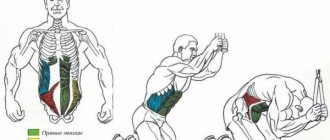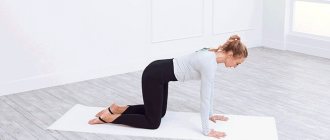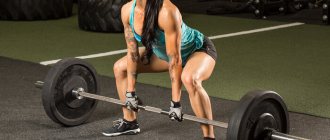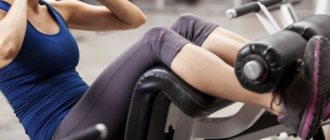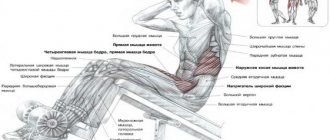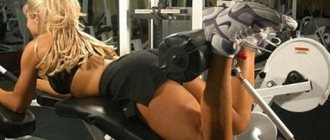Benefits and disadvantages of exercise
The main benefit of the lumberjack ab exercise is that the movement engages almost all the muscles of the upper body. In terms of muscle fiber recruitment, the woodcutter on the block is superior to almost all other movements for working the abdomen.
Main advantages:
- Working out the oblique and rectus abdominal muscles.
- Improves posture by strengthening your core and upper back muscles.
- Ability to perform movements with heavier weights, accelerating progression.
- Ideal for creating “teeth” in the oblique muscles and increasing their size.
- Develops explosive strength and the ability to quickly contract the abdominal muscles (often used in martial arts).
- Equally effective for both beginners and professional athletes.
The exercise does not have any disadvantages. The only possible disadvantage is the lack of mastery of the technique, in which the main load falls on the arms, which makes the movement less useful for the target area.
What are the benefits of exercise?
What does the lumberjack abs exercise do, besides pumping up your abs and the opportunity to get sculpted abs on your stomach? The benefits of it are very multifaceted, since with its help you will receive the following advantages:
- comprehensively develops all abdominal muscles, including obliques;
- strengthens core muscles; increases explosive power;
- makes the body more massive;
- improves posture;
- Helps improve performance in sports such as tennis and golf.
Despite all the benefits, the lumberjack breathing exercise for abs should be performed as technically and carefully as possible so as not to harm yourself. For example, if you have a wide waist, do not overdo it, otherwise you will widen it even more by pumping up the oblique muscles.
What muscles work
During the classic movement, the load falls on:
- Oblique abdominal muscles.
- Rectus abdominis muscle.
- Transverse muscle.
- Lower back.
Additional burden falls on:
- Lat.
- Deltas.
- Triceps.
- Back extensors.
Execution options
"Lumberjack" on the lower block
In this version, the “Lumberjack” exercise on a block puts a good load on the legs. Another advantage of this method is that it requires more energy, so it is good for fat-burning training.
Exercise “Lumberjack” with dumbbells
This option is suitable for you if you work out at home and do not have the opportunity to perform body rotations on a block simulator:
- starting position - standing, body turned to the right, dumbbell held in hands over right shoulder;
- as you exhale, turn to the left, lowering the weight to your hip;
- while inhaling, return to the starting position;
- Complete the required number of repetitions and switch sides.
With a barbell
This option uses a barbell, one end of which lies on the floor and the other is held in the hands:
- approach the apparatus, grab the end of the bar with both hands and lift it up so that the weights are at the level of your face;
- perform turns in one direction and the other, lowering the weight alternately to the right and left thigh.
Lumberjack exercise on a block
A woodcutter in a crossover is the simplest and most convenient option for any gym. With this option, the load falls evenly on all muscles, and it is also possible to minimize the involvement of the hands in the work.
Technique:
- Attach a rope or D-handle to the top pulley.
- Stand with your side to the machine and grab the handle with both hands. The back is straight, feet shoulder-width apart.
- Begin with a powerful movement to lower the handle diagonally towards your knee or thigh (depending on the length of your arms). Rotate your body using your oblique muscles. To lower the weight lower, a slight tilt of the body is allowed with a straight back.
- Take a minimal pause and at a slower pace return the handle to the starting position.
It is important to understand that the main movement is carried out by the body and core muscles.
Beginners should learn to relax their arms and shoulders as much as possible so that they do not “pull” the main load onto themselves.
How to do it correctly?
Let's first consider how to correctly do the classic woodcutter exercise. To do this, you will need a crossover simulator or an upper block, to the carabiner of which you need to attach a tape handle. Stand at your side, extend your arms up and slightly to the side diagonally, and grab the handle. Turn the body slightly in the same direction. Feet should be shoulder-width apart with knees slightly bent.
As you exhale, in one motion, pull the handle down diagonally relative to your torso in the opposite direction, turning your torso. Your arms and back should remain straight, and after bringing the handle to the bottom, smoothly return to the starting position. Perform 8-12 repetitions, and then change the position to a mirror position and repeat the exercise. For clarity, we recommend watching a video of the woodcutter exercise, in which it is performed on a block.
Reverse Lumberjack
Reverse lumberjack exercise
Unlike the classic version, the reverse lumberjack emphasizes the upper obliques, deltoids, and lats.
Technique:
- Attach the handle to the lower block and hold it with both hands. Bend down slightly (with a straight back).
- With a powerful jerking movement, move the weight from the bottom position to the top position diagonally. At the same time straighten your back.
- At a slower pace, return the handle to the starting position.
As with the upper block, it is important to feel the load even in the starting position. To do this, you should move half a step away from the machine to ensure tension on the cable.
Features of abdominal training with dumbbells
The option of pumping the press using weights is usually called power.
However, it is he who provides a truly powerful load on the entire abdominal area. The abdominal muscles are almost no different from other muscles of the body. To progress, they also need a load that will gradually increase. Working with your own body weight is good only in the beginning, although gradually its benefits fade away due to the fact that the body adapts to the load. To tone your abs with dumbbells, you need to perform a small number of exercises, allowing enough time for recovery. You should also pay attention to key points when working with weights:
- Movements should be smooth and slow (due to the increased risk of injury).
- Exercises are selected so as to eliminate increased stress on the lower back (no Roman chair).
- Work with a small number of repetitions (10-12).
- Rest between sets – 2 minutes.
- Increase the weight used to maintain the progression of the load.
Lumberjack exercise with dumbbells
A woodcutter with a dumbbell is considered a rather inconvenient option, although once you master the technique it can become a worthy replacement for other versions. Unlike a crossover, it puts more stress on the arms and shoulders (which are forced to make an effort to lift the weight or prevent it from falling). Refers to the reverse type.
Technique:
- Hold a dumbbell in both hands and stand straight with your feet shoulder-width apart. Hold the projectile at knee level with your body slightly tilted forward.
- With a quick movement, move the dumbbell in an arc to the level of the opposite shoulder (from the left knee to the right shoulder and vice versa).
- Without pausing, return the dumbbell to the starting position.
It is important to avoid “throwing” the weight down by inertia; this is a key point for correct execution.
You should also be careful not to hit your knee with the dumbbell when lowering the apparatus.
Abs training complex for men
1. Abdominal crunches.
2. Vertical and horizontal “scissors”. Lying on the floor, perform horizontal and vertical movements with legs raised 30 cm from the floor.
3. "Bicycle". Lying on the floor and raising your shoulders, as in straight crunches, try to reach the knee on the opposite side with your elbow, while simultaneously pulling your leg bent at the knee towards the elbow.
4. Climber exercise. The starting position is like push-ups. As you inhale, pull your knee toward your chest, and as you exhale, straighten your leg. Then repeat the same with the other leg. Perform at a fast pace for 30 seconds or longer.
Read more: Amino 5600 from scitec nutrition: how to take, reviews
5. Raising your legs on the crossbar, horizontal bar (if there is no stadium or wall bars nearby at home, then you can lie on the floor).
Lumberjack exercise with kettlebell
The lumberjack with a kettlebell is a great example of proper strength training. The inertia of the projectile allows you to make the exercise analogous to swings, but with an emphasis on the oblique muscles. The main feature of the kettlebell version is which muscles are worked. Due to the weight of the projectile, almost the entire upper body is extremely loaded; this is an ideal option for increasing mass and strength.
The technique is similar to the version with dumbbells, but with the difference that at the top point it is necessary to “dampen” the inertia due to the muscles of the shoulders and hands.
Working muscles
What muscles work during the lumberjack exercise? This depends in part on the technique chosen, but the main muscle groups involved are:
- oblique abdominal muscles – internal and external;
- rectus abdominis muscle;
- transverse abdominal muscles.
The obliques are located in the lateral parts of the body and run diagonally, so when performing chopping movements they are heavily loaded and pumped. Well-developed core muscles reliably hold the spine, protecting it during sharp and traumatic turns of the body.
How to replace the exercise
Alas, one movement cannot replace this exercise without loss of effectiveness. This is due to its complex nature. Among the most optimal options for replacement are:
- A combination of lateral and classic twists.
- Combining the regular climber version with a crossover variation (the knee moves toward the opposite shoulder).
- A superset of Roman chair crunches and hanging leg raises (with legs moving to the sides).
Common mistakes
Beginners sometimes make mistakes when performing the lumberjack exercise on a block or with dumbbells, which we want to warn you against. First of all, always start training with light weights and work on your technique before increasing the weight.
When doing the lumberjack, your feet should remain stationary and your abdominal muscles should be statically tense. A relaxed press will ruin everything! Control the position of your head and do not lower it, but keep it in line with the spine.
The mistake that athletes make when performing the woodcutter exercise is often bending their arms at the elbow joints, so the entire load goes not on the body, but on the arms.
The second mistake athletes make is arching their back. During training, all the strength goes to the spine. This leads to sprains and serious injuries.
If you liked the exercise called woodcutter, be sure to try it. In order to perform it in strict accordance with the technique and requirements (the result depends on this), start training with a personal trainer.
Workout 1 Chest and back week 1
1A Bench press on the floor
Sets: 4, reps: 10, rest: 0 sec, tempo: 2010
Technique: Lie on the floor, holding dumbbells with straight arms above your chest. Lower the weight to your chest, then lift it up to the starting position.
Note: Lying on the floor provides you with a stable position that allows you to handle heavier weights. The range of motion here is shorter than the classic bench press, so focus on properly contracting your chest muscles.
1B Bent-over row with hammer grip
Sets: 4, reps: 10, rest: 0 sec, tempo: 2010
Technique: Hold a dumbbell in each hand with your palms facing each other. Bend forward and then pull the dumbbells toward your chest. Using a controlled movement, lower the weight back to the starting position.
Note: This exercise targets the large muscles of the upper back. Its lower part is under tension to support the torso in an inclined position. The hammer grip allows you to work your forearms.
2A Push-ups with dumbbells
Sets: 4, reps: 10, rest: 0 sec, tempo: 2010
Technique: take dumbbells, take a lying position with your hands shoulder-width apart. Brace your core and straighten your body into a straight line from head to toes. Bend your elbows, lower your body, and then with an energetic movement, straighten your arms and return to the starting position.
Note: Push-ups are effective for building chest muscles, especially when you use dumbbells to add instability to the movement, which forces your core muscles to engage.
2B Bent-over dumbbell raises
Sets: 4, reps: 10, rest: 60 sec, tempo: 2010
Technique: Hold a light dumbbell in each hand and lean forward without rounding your back. Maintaining a slight bend in your elbows, lift the dumbbells to shoulder height, then lower them back to the starting position.
Note: This exercise literally works wonders for your upper back and rear deltoids. Start with light weights and master the technique thoroughly to maximize muscle strength and reduce the risk of injury.
3A Wide Hand Push-Ups
Sets: 4, reps: 10, rest: 0 sec, tempo: 2010
Technique: Take dumbbells, lie down, spread your arms wide and bring your legs together. Brace your core and straighten your body into a straight line from head to toes. Bend your elbows to lower your body, and then vigorously straighten your arms and return to the starting position.
Note: Wide stance reduces the involvement of the triceps and shoulders, so that the main load falls on the chest muscles.
3B Lying dumbbell row
Sets: 4, reps: 10, rest: 60 sec, tempo: 2010
Technique: take dumbbells, lie down with your hands shoulder-width apart. Brace your core and straighten your body into a straight line from head to toes. Pull one dumbbell toward your chest, lower it back down, and then repeat with the other arm.
Note: One movement of this exercise works one side of your upper back (so you can fully target every muscle) and also forces you to engage your core and shoulder joints to keep your body in a stable position.
Week 2
| Exercise | Approaches | Repetitions | Rest, sec | Pace |
| 1A Bench press on the floor | 4 | 12 | 2010 | |
| 1B Bent-over row with hammer grip | 4 | 12 | 60 | 2010 |
| 2A Push-ups with dumbbells | 4 | 12 | 2010 | |
| 2B Bent-over dumbbell raises | 4 | 12 | 60 | 2010 |
| 3A Push-ups with wide arms | 4 | 12 | 2010 | |
| 3B Lying dumbbell row | 4 | 12 per side | 60 | 2010 |
Week 3
| Exercise | Approaches | Repetitions | Rest, sec | Pace |
| 1A Bench press on the floor | 4 | 10 | 2010 | |
| 1B Bent-over row with hammer grip | 4 | 10 | 60 | 2011 |
| 2A Push-ups with dumbbells | 4 | 10 | 2010 | |
| 2B Bent-over dumbbell raises | 4 | 10 | 60 | 2011 |
| 3A Push-ups with wide arms | 4 | 10 | 2011 | |
| 3B Lying dumbbell row | 4 | 10 per side | 60 | 2010 |
Week 4
| Exercise | Approaches | Repetitions | Rest, sec | Pace |
| 1A Bench press on the floor | 5 | 12 | 2010 | |
| 1B Bent-over row with hammer grip | 5 | 12 | 60 | 2011 |
| 2A Push-ups with dumbbells | 5 | 12 | 3010 | |
| 2B Bent-over dumbbell raises | 5 | 12 | 60 | 2011 |
| 3A Push-ups with wide arms | 5 | 12 | 3010 | |
| 3B Lying dumbbell row | 5 | 12 per side | 60 | 2011 |
Execution technique
Most strength exercises are aimed at working a specific muscle group. "The Woodcutter" is an exception to the general rules. Performing the exercise regularly during circuit training will provide a number of benefits:
- development of the abdominal muscle corset;
- formation of a slim waist;
- strengthening the back muscles;
- formation of core muscles;
- under certain conditions, weight loss is possible;
- formation of abs cubes.
The exercise is performed on a special block simulator. In the starting position, approaching the sports equipment, the left leg should be put forward, while the right leg should be moved back. You need to grab the handrail with both hands. The body should be turned to the right, in an arc, the handle should be pulled towards the thigh of the opposite leg. At the end point, your arms should be completely straightened. You need to return to the starting position slowly.
View gallery
The exercise is done on each side in turn. There are several variations of training that help additionally work out the desired muscle groups. The most popular among them are exercises with dumbbells and kettlebells.
COMMUNITY EDITING
Yesterday at one forum I had a good discussion with local regulars on the topic of core muscle training. Unfortunately, we never came to a general consensus, but during the conversation I remembered one very good exercise that I actively practiced a couple of years ago. Since I'm not greedy, I decided to share it with you :) Interesting? Details below!
Lumberjack: an exercise for effectively pumping the core
And so, this exercise is called woodcutter. It allows you to load all the abdominal muscles at once - obliques, transverses, rectus. The essence of the exercise (as its name “transparently” hints at) is to perform movements with your hands similar to those made when chopping wood.
Correct technique is the key to success
Now let's talk about how to perform this exercise correctly. Face the pulley machine and firmly grasp the handle with both hands, placing your palm on your palm (note: when turning to the right, your left hand should be on top, and when turning to the left, your right hand should be on top). Start pulling the handle as if in an arc from top to bottom, while at the same time turning the body to the side. Try to do this not by using the strength of your arms, but by tensing your abdominal muscles.
Are you working out at home? No problem!
If you prefer to work out in splendid isolation and do not have access to a block simulator, it doesn’t matter - the woodcutter can be done at home. But for this you will need a dumbbell, or any other weight - a heavy ball, bag, etc.
The principle of performing the exercise remains the same as when working on a machine: take a dumbbell (or other weight) with both hands and lift it above your head. Tensing the abdominal muscles as much as possible, we begin to swing the dumbbells in an arc, lowering it to the left thigh and raising it back. When moving up, inhale; down, exhale. The exercise is performed at a fast pace (the faster you work, the stronger the abdominal muscles will contract) for one minute on each side. There is a one-minute break between approaches.
Let's sum it up
I’m already a little tired of writing something, so perhaps we’ll wrap it up. But before we finish, let's summarize. And so, the exercise can be performed either on a block simulator or simply with a dumbbell (or any other weighting material). The movement is performed from top to bottom in an arc; you need to work at a fast pace, tensing your abdominal muscles as much as possible. Lifting is done while inhaling, and lowering is done while exhaling.
Well, that's all the main points of this exercise. Perform it regularly, adhere to the described technique, and you will be provided with beautiful abdominal muscles. Let's end on this optimistic note :)
